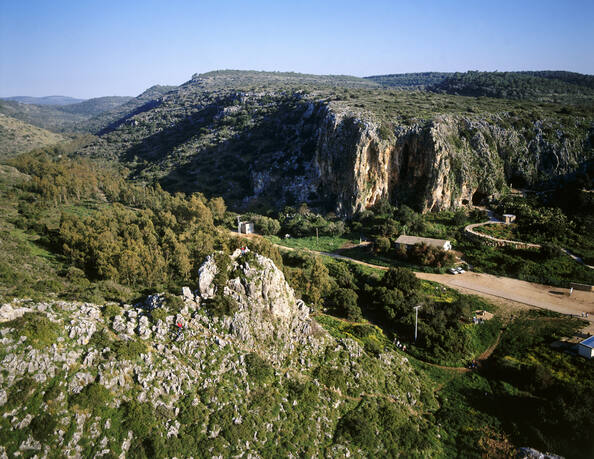Sitio de evolución humana del Monte Carmelo: cuevas del Nahal Me’arot/Uadi Al Mughara
Sites of Human Evolution at Mount Carmel: The Nahal Me’arot / Wadi el-Mughara Caves
Situated on the western slopes of the Mount Carmel range, the site includes the caves of Tabun, Jamal, el-Wad and Skhul. Ninety years of archaeological research have revealed a cultural sequence of unparalleled duration, providing an archive of early human life in south-west Asia. This 54 ha property contains cultural deposits representing at least 500,000 years of human evolution demonstrating the unique existence of both Neanderthals andEarly Anatomically Modern Humans within the same Middle Palaeolithic cultural framework, the Mousterian. Evidence from numerous Natufian burials and early stone architecture represents the transition from a hunter-gathering lifestyle to agriculture and animal husbandry. As a result, the caves have become a key site of the chrono-stratigraphic framework for human evolution in general, and the prehistory of the Levant in particular.
Description is available under license CC-BY-SA IGO 3.0
Sites de l’évolution humaine du mont Carmel : les grottes de Nahal Me’arot / Wadi el-Mughara
Situé sur le versant occidental du mont Carmel, ce bien comprend les grottes de Taboun, Jamal, el-Wad et Skhul. Quatre-vingt-dix années de recherche archéologique ont mis à jour une séquence culturelle, d’une durée sans équivalent, offrant des archives sur les origines humaines en Asie du sud-ouest. Ce bien de 54 ha contient des gisements culturels représentant au moins 500000 ans d’évolution humaine, seul complexe connu contenant tout à la fois des restes d’hommes de Néandertal et des premiers humains anatomiquement modernes dans un même ensemble culturel du Paléolithique moyen, le Moustérien. Des témoignages des pratiques funéraires natoufiennes et des premières manifestations de l’architecture en pierre illustrent la transition d’un mode de vie de type chasseur-cueilleur vers l’agriculture et l’élevage. A ce titre les grottes sont devenues un site essentiel du cadre chrono-stratigraphique de l’évolution humaine en général et de la préhistoire du Levant en particulier.
Description is available under license CC-BY-SA IGO 3.0
Находки на горе Кармель, отражающие эволюционное развитие человека: пещеры Нахаль Меарот и Вади эль-Мугара
Находки на горе Кармель, отражающие эволюционное развитие человека: пещеры Нахаль Меарот и Вади эль-Мугара (Израиль), а также пещеры Табун, Джамаль, эль-Вад и Схул расположены на западном склоне горного хребта Кармель. Они занимают площадь более 54 гектаров и таят культурные слои, представляющие 500 тыс. лет человеческой эволюции. В пещерах обнаружены убедительные подтверждения существования захоронений и ранних каменных построек периода перехода от племён охотников-собирателей к обществу скотоводов и земледельцев. На сегодняшний день это единственный археолого-культурный комплекс, где были обнаружены ископаемые останки неандертальцев и ранних представителей анатомически современного человека, относящиеся к одному времени, что усиливает споры вокруг исчезновения неандертальцев и эволюции Homo sapiens. Девяносто лет археологических исследований помогли обнаружить здесь культурные находки за удивительно долгий период, что позволяет получить информацию о ранних этапах эволюции человека в юго-западной Азии.
source: UNESCO/CPE
Description is available under license CC-BY-SA IGO 3.0
Sitio de evolución humana del Monte Carmelo: cuevas del Nahal Me’arot/Uadi Al Mughara
Situado en la ladera occidental del Monte Carmelo, el sitio comprende las cuevas de Tabun, Jamal, Al Uad y Skhul. Abarca 54 hectáreas y contiene vestigios culturales que constituyen un testimonio de 500.000 años de la evolución humana con restos de lugares de enterramiento, arquitectura primitiva en piedra y de la transición del modo de vida humano basado en la caza y la recolección a la práctica de la agricultura y la ganadería. Este sitio es, hasta la fecha, el único en el que se han hallado vestigios de fósiles del Hombre de Neanderthal y de los primeros humanos dotados con la anatomía actual de nuestra especie en el seno de un mismo conjunto cultural del Paleolítico medio, el mosteriano. Se trata de un sitio esencial del marco cronoestratográfico de la evolución humana en general y de la prehistoria del Levante en particular. Noventa años de excavaciones arqueológicas han puesto de manifiesto una secuencia cultural de duración inigualada, que constituye todo un archivo de la vida de los hombres primitivos en el sudoeste de Asia.
source: UNESCO/CPE
Description is available under license CC-BY-SA IGO 3.0
人類の進化を示すカルメル山の遺跡:ナハル・メアロット/ワディ・エルムガーラ渓谷の洞窟群
イスラエル北部、カルメル山の4つの洞窟と、その全円の段丘に立地する遺跡群。50万年前の旧石器時代前期のアシュール文化から、終末期のナトゥーフ文化までの様相を示し、人類進化や文化の変遷を長期にわたって示す遺跡。これらの遺跡は、ムスティエ期にネアンデルタール人と現生人類が同時に生存していたことや、ナトゥーフ期に旧石器時代最後の狩猟採集社会から新石器時代の定住農耕社会へと移行した過程などを証明している。source: NFUAJ
Menselijke evolutiegebieden op de berg Karmel: de Nahal Me’arot en Wadi el-Mughara grotten
Op de westelijke helling van de bergketen Karmel bevinden zich de grotten van Tabun, Jamal, el-Wad en Skhul. Dit gebied beslaat 54 hectare en bevat culturele overblijfselen die 500.000 jaar menselijke evolutie vertegenwoordigen. Er zijn restanten gevonden die verwijzen naar begrafenisceremonies, vroege stenen architectuur en naar een overgang van een levensstijl van jagen naar die van landbouw en veeteelt. Hieruit blijkt het bestaan van zowel Neanderthalers, als de vroege anatomisch moderne mens binnen hetzelfde middenpaleolithische culturele kader, het Moustérien. Negentig jaar archeologisch onderzoek heeft een culturele opeenvolging van ongeëvenaarde duur blootgelegd, waarmee het ons een ’archief’ biedt van het vroege menselijke leven in het zuidwesten van Azië.
Source: unesco.nl
